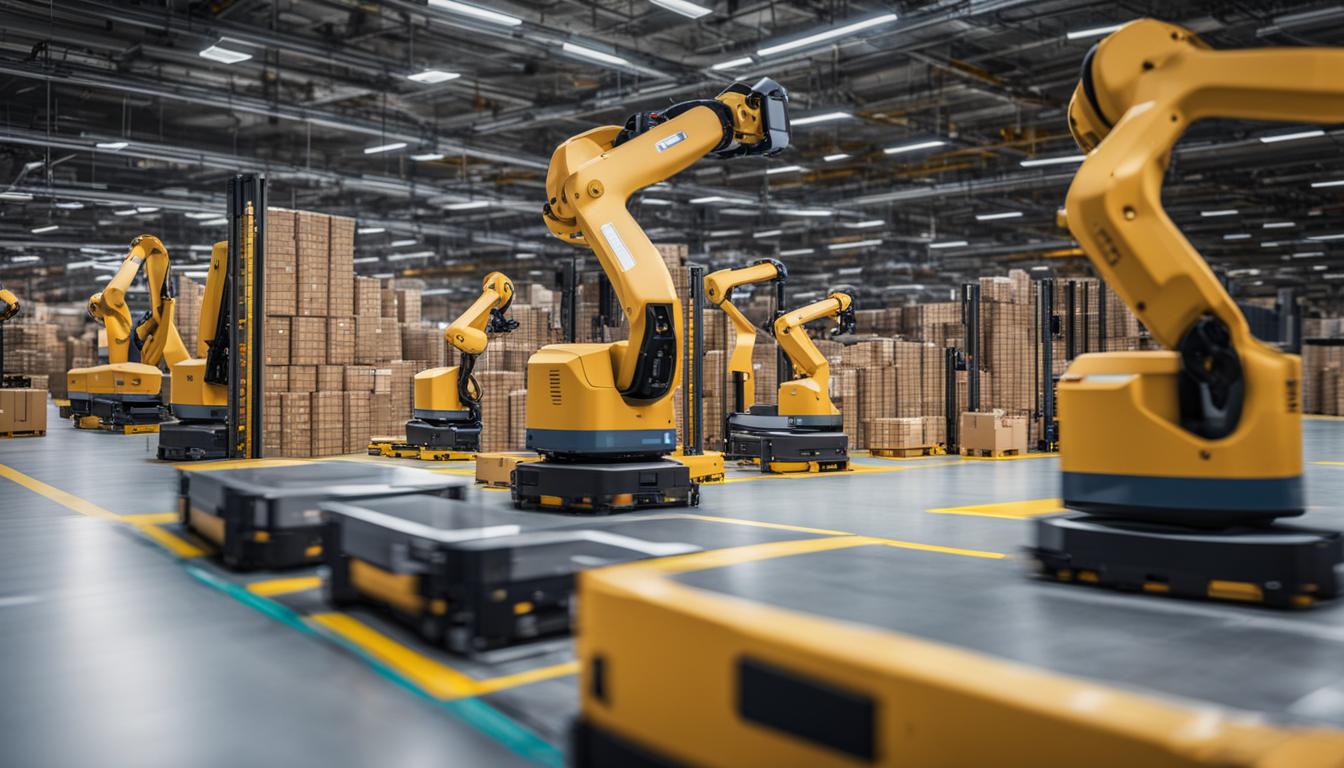The international shipping industry faces numerous challenges, including delays, damaged goods, and high operational costs. However, there is a solution that is revolutionizing the logistics industry – cargo handling robotics. These advanced robots are designed to handle, sort, and transport goods with precision, offering a game-changing solution to the industry’s pain points.
Cargo handling robots are capable of performing a wide range of tasks, such as picking and packing goods, sorting packages, loading and unloading cargo, and managing inventory. Their use in ports and warehouses has led to faster turnaround times and improved customer satisfaction. With their efficiency and accuracy, these robots greatly reduce the time needed for loading and unloading, minimizing the risk of misplaced or lost cargo.
As technology continues to advance, cargo handling robots are becoming even more efficient with the integration of artificial intelligence (AI) and machine learning. This integration allows robots to adapt and learn from their experiences, optimizing their performance over time.
Key Takeaways:
- Cargo handling robotics revolutionize the logistics industry by addressing challenges such as delays and damaged goods.
- These robots perform tasks like picking, packing, sorting, and managing inventory with precision and efficiency.
- The use of cargo handling robots in ports and warehouses leads to faster turnaround times and improved customer satisfaction.
- With the integration of AI and machine learning, cargo handling robots continue to become more efficient over time.
- Cargo handling robotics is paving the way for a more efficient and sustainable logistics industry.
The Growing Role of Robotics in the Transportation and Logistics Industry
The transportation and logistics industry is experiencing a significant transformation with the increasing integration of robotics and AI technologies. These advancements are revolutionizing the way cargo is handled, resulting in improved efficiency, reduced costs, and enhanced productivity. With the rising demand for automated cargo handling solutions, the global logistics robot market is projected to reach a value of $21.01 billion in the next seven years.
One of the key areas where robotics is making a substantial impact is in warehouses. Robotic systems are being used to automate tasks such as picking, packing, and inventory management. By leveraging the capabilities of robots, logistics companies can achieve higher accuracy and productivity levels while minimizing errors and delays. Additionally, self-driving trucks operated by AI technology are addressing the industry’s ongoing challenge of driver shortage and decreasing operational costs.
The use of drones is also gaining prominence in the transportation and logistics industry. Companies are utilizing drones for same-day delivery services, particularly in the booming e-commerce sector. Drones offer faster and more efficient deliveries, requiring fewer manpower resources and reducing long-term expenses. Furthermore, they have the potential to simplify inspection processes and monitor cargo loading and unloading, bringing further automation to port operations.
The integration of robotics into the transportation and logistics industry is expected to drive tremendous economic growth in the coming years. As technology continues to advance, we can anticipate even more sophisticated robotics solutions that leverage AI and machine learning to further streamline and optimize cargo handling processes.
Table: Applications of Robotics in Transportation and Logistics
| Application | Description |
|---|---|
| Warehouse Automation | Robots used for picking, packing, and inventory management in warehouses, improving efficiency and accuracy. |
| Self-driving Trucks | Autonomous trucks that operate without human drivers, reducing operational costs and addressing driver shortages. |
| Drones | Unmanned aerial vehicles used for quick and efficient deliveries, as well as simplifying inspection processes in the logistics industry. |
Warehouse Robots: Transforming the Warehousing Process
The use of warehouse robots has revolutionized the way warehouses operate, transforming the entire warehousing process. These robotic solutions for cargo handling have brought about increased efficiency, accuracy, and organization, while also minimizing human errors. Warehouse robots, such as automated guided vehicles (AGVs) and automated storage and retrieval systems (AS/RS), are capable of performing a wide range of tasks, including picking, packing, putting away, and receiving operations.
One of the major advantages of warehouse robots is their ability to handle repetitive tasks, which eliminates the risk of human fatigue and reduces the occurrence of errors. These robots can pick up and move items with precision, ensuring that goods are stored in the correct location. They can also close and seal boxes, optimizing the packaging process and ensuring that items are well-protected during transportation.
Furthermore, warehouse robots play a crucial role in inventory management. They can assist with stock counting, ensuring that accurate records are maintained at all times. By automating these inventory-related tasks, warehouse robots enable real-time tracking and eliminate the need for manual counting, saving time and improving overall efficiency.
Benefits of Warehouse Robots:
- Increased efficiency and productivity
- Improved accuracy and organization
- Minimized human errors
- Optimized packaging and inventory management
- Real-time tracking and stock control
With their ability to automate various aspects of the warehousing process, warehouse robots have become an integral part of the transportation and logistics industry. Their implementation not only reduces dependency on human workers but also enhances employee retention rates. As the technology continues to advance, we can expect further development and integration of AI and machine learning in warehouse robotics, leading to even more efficient and sophisticated solutions.
| Robotic Solution | Function |
|---|---|
| Automated Guided Vehicles (AGVs) | Handle picking, packing, putting away, and receiving operations |
| Automated Storage and Retrieval Systems (AS/RS) | Retrieve and store items in designated locations |
The Rise of Self-Driving Trucks in Logistics
Self-driving trucks, powered by AI and machine learning technology, are revolutionizing the logistics industry. These autonomous vehicles offer a solution to the growing problem of driver shortages in the road freight sector. By eliminating the need for human drivers, self-driving trucks reduce operational costs and achieve greater fuel efficiency. This advancement in cargo automation brings increased efficiency and profitability for logistics companies.
While self-driving trucks are a game-changer in the industry, it’s important to note that certain types of cargo, such as vehicles and aircraft engines, may still require manual handling. The automation of the freight sector attracts a new type of employee, one with technical expertise in operating hi-tech equipment. As the industry embraces this technology, it’s crucial to strike a balance between technology adoption and upskilling the workforce.
Self-driving trucks are transforming the logistics industry, eliminating the need for human drivers and reducing operational costs. By embracing automation and robotics, the industry can achieve increased efficiency and sustainable growth.
The rise of self-driving trucks in logistics is part of a broader trend of robotics and automation in the transportation sector. These advancements are reshaping the industry, reducing delays, improving accuracy, and enhancing overall customer satisfaction. As technology continues to evolve, self-driving trucks will play a significant role in streamlining the supply chain and providing efficient and reliable transportation solutions.
| Benefits of Self-Driving Trucks in Logistics |
|---|
| Reduces operational costs |
| Addresses driver shortages |
| Increases fuel efficiency |
| Improves overall efficiency and profitability |
The Role of Drones in Transportation and Logistics
Drones are rapidly becoming indispensable tools in the transportation and logistics industry. With their ability to navigate difficult terrains and deliver goods efficiently, they are revolutionizing the way businesses handle cargo. The use of drones in this sector brings numerous benefits, including faster delivery times, reduced costs, and increased efficiency.
One of the key advantages of using drones for cargo handling is their ability to perform same-day deliveries, particularly in the e-commerce sector. Drones can bypass traffic and deliver packages directly to customers’ doorsteps, ensuring quick and reliable service. This not only improves customer satisfaction but also allows businesses to streamline their operations and reduce long-term expenses.
In addition to delivery services, drones are also valuable in the ocean freight sector. They can be used to simplify inspection and review processes, monitor loading and unloading of cargo, and enhance overall port operations. Drones provide real-time aerial views, enabling logistics companies to monitor their operations more effectively and make informed decisions. This level of automation brings efficiency, accuracy, and cost savings to the industry.
The Future of Drone Technology in Logistics
The role of drones in transportation and logistics is only expected to grow in the coming years. As technology continues to advance, we can anticipate further developments in drone capabilities and applications. For instance, drones equipped with advanced sensors and AI algorithms can be programmed to autonomously assess cargo conditions, detect anomalies, and even perform basic maintenance tasks.
Furthermore, the integration of drones with other technologies, such as blockchain and IoT, could enhance the traceability and security of cargo throughout the supply chain. This would enable businesses to track their shipments more effectively, reduce the risk of theft or tampering, and ensure compliance with regulations.
In conclusion, drones are playing a vital role in transforming the transportation and logistics industry. Their ability to deliver goods quickly, reduce costs, and improve efficiency makes them an ideal solution for cargo handling. As the technology continues to evolve, we can expect drones to become even more integral to the logistics ecosystem, driving innovation and reshaping the way goods are transported and delivered.
Conclusion
The rise of cargo handling technology and robotic solutions for cargo handling is revolutionizing the logistics industry. These advancements offer promising solutions to challenges faced by the international shipping industry, such as delays, damaged goods, and high operational costs. Logistics robots, with their ability to handle, sort, and transport goods with precision, are bringing efficiency and accuracy to warehouses and ports.
In warehouses, robotic solutions such as automated guided vehicles and automated storage and retrieval systems are automating repetitive tasks, improving efficiency, accuracy, and organization. These robots not only handle picking, packing, and inventory management but also reduce dependency on human workers, leading to higher employee retention rates.
Self-driving trucks and drones are also playing significant roles in transportation and logistics. Self-driving trucks, operated by AI and machine learning technology, are addressing the problem of driver shortage, reducing operational costs, and increasing efficiency and profit margins. Drones, on the other hand, enable quick and efficient deliveries, particularly in the e-commerce sector, while reducing long-term expenses for companies.
As the logistics industry continues to embrace automation and robotics, it is crucial to strike a balance between technology adoption and upskilling the workforce. The integration of AI and machine learning holds the key to a more efficient and sustainable industry. With the potential to further streamline operations and improve customer satisfaction, cargo handling technology and robotic solutions are shaping the future of logistics.
- Customer Engagement and Loyalty: Innovating the Future of Saudi Arabia’s Dedicated Cargo Airline - December 23, 2024
- Regulatory and Compliance: Pioneering the Future of Saudi Arabia’s Dedicated Cargo Airline - December 21, 2024
- Financial Strategies: Fueling the Growth of Saudi Arabia’s Dedicated Cargo Airline - December 20, 2024






